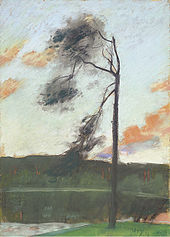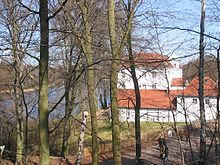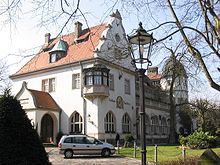Grunewaldsee
| Grunewaldsee | ||
|---|---|---|

|
||
| Grunewaldsee on the south bank | ||
| Geographical location | Berlin-Grunewald | |
| Data | ||
| Coordinates | 52 ° 28 '12 " N , 13 ° 15' 45" E | |
|
|
||
| surface | 17.5 ha | |

The Grunewaldsee is located in the west of the Charlottenburg-Wilmersdorf district of Berlin , on the edge of the Grunewald . The lake with an area of around 175,000 m² belongs to the glacial channel of the Grunewald chain of lakes . The Hundekehlefenn nature reserve and the Hundekehlesee follow to the north, and the two nature reserves Langes Luch and Riemeisterfenn and then the Krumme Lanke follow in the chain of lakes to the south-west .
On the lake lies the Grunewald hunting lodge from 1542, the oldest castle in the city and the only evidence of the early Berlin renaissance . A part of the bank area is designated as a nature reserve and at the same time the Grunewaldsee is Berlin's most popular run-out area for dogs - a constant conflict of interests and bone of contention in the city. While the lake itself fully in the district of Grunewald of the district of Charlottenburg-Wilmersdorf district, are a part of the south-eastern shore, the hunting lodge and the historical hunting restaurant and hotel Paulsborn to the district Dahlem the district Steglitz-Zehlendorf .
Sights on the lake
Hunting lodge named after him
The lake is named after the Grunewald hunting lodge, which Elector Joachim II had built in 1542. Even today, the sandstone plaque from 1542 above the door frame under the deer relief that is also still present gives information about the name. The inscription consists of many abbreviations, which are added in brackets in the following rendering:
… V [ND] DEN • VII MARC [IUS] • THE • FIRST [TEN] STONE • GE [LAY] • V [ND] • Z [UM] GRVENEN • FOREST • GENENT •
After this house "Zum Grünen Wald", later "Aufm Grünwald", the lake was named "Grunewaldsche See" (map from 1792). According to documents, the surrounding forest was called "Teltowische Heide" (after the Teltow ) in 1542 and still in 1698 , and on the map from 1792 "Spandauer Forst" (Royal Spandausches Forest District), and it was only around 1800 that it was called "Grunewald". This was in turn transferred to the emerging colony, today's Grunewald district, at the end of the 19th century.
Overview of the castle history
The Grunewald hunting lodge from 1542 was surrounded by a moat until the 17th century and was originally designed as a moated castle . It is very likely that it was built under the direction of the electoral builders Caspar Theiss and Hans Schenk . As a connection between Grunewaldsee and the Berlin City Palace , the builders built a stick dam through the former marshland , the origin of today's Kurfürstendamm . At the beginning of the 18th century, Friedrich I , the first king in Prussia , had the Renaissance palace rebuilt and expanded. The baroque design was completed in 1708, the surrounding moats were filled in and planted.
Exhibitions today
When the Grunewald was abandoned as a court hunting area in 1904 , the castle found a new use as a museum . In the 1960s and 1970s, after intensive research into the old building plans, a comprehensive and detailed historical restoration was carried out, and shortly before the turn of the millennium for the 450th anniversary. Today, the palace houses exhibitions on the history of the building and the history of the Hohenzollern family and the extensive collection of paintings by the electors, which has been supplemented by other works. Her focus is on Dutch painting of the 17th century and on old German masters. The “Jagdzeugmagazin” contains an accessible hunting collection with originals, most of which come from the holdings of the Zeughaus Berlin , as the fittings in the Grunewald arsenal have disappeared. (See main article: Jagdschloss Grunewald .)
Paulsborn
The farmstead and later forester's house Paulsborn, which was laid out in 1800 in the neighborhood further south by the lake, is also worth seeing. In 1806 an inn was built here that belonged to an innkeeper Paul. It was published in 1817, 1840 and 1858 as an establishment “belonging to Dahlem”. In 1860 there was a hunter's house next to the inn. There was a residential and three farm buildings on the district. In 1871 Kaiser Wilhelm I inaugurated an inn here, and in 1905 Paulsborn received the restaurant building that still exists today in a splendid neo-renaissance, with many allusions to the hunting lodge. Antique paintings, lead-glazed windows, columns and antler lamps convey a nostalgic atmosphere.
Hydrogeology and ecology of the lake
Water level

Today it is difficult to imagine that the hunting lodge, which is surrounded by land and located a bit above the lake, was originally a moated castle and was only accessible via a bridge. In the middle of the second millennium, the level of the Grunewaldsee was around two meters higher than it is today and was lowered several times, for example as early as 1800, to enable peat cutting on the Dahlem meadows . The connecting canal to the Langen Luch and Riemeisterfenn dates from this time and led the water to the Krummen Lanke . The lake experienced further sinking levels due to the abstraction of groundwater , which has been carried out since the beginning of the 20th century to supply the rapidly growing population in the greater Berlin area with drinking water. Since the groundwater levels in the Berlin area also fell, the lake , which was originally only fed by groundwater, is now additionally fed via water from the rain sewer system , which leads to problems with the water quality.
Nature reserve
As part of the forest, the entire area belongs to the Grunewald landscape conservation area. The southern part of the Grunewaldsee with its shoreline areas has also been designated as a nature reserve with the classification “waters / moor” on an area of 9.6 hectares since 1988 . Most of it belongs to the Charlottenburg-Wilmersdorf district and a small part to the Steglitz-Zehlendorf district. Plants dominate the riparian zones, preferring damp and wet locations, and in a few areas there are remains of alder forests . Like the bank areas of almost all bodies of water in the Grunewaldsee chain, with the exception of Lake Nikolasse , the banks of the Grunewaldsee are only sparsely overgrown with reed beds , so that there are hardly any fish species that belong to the herb spawners . In Grunewaldsee outweigh eels , tench , pike , carp , catfish , and from the family of perch , the perch . It is only through the recent care measures that it has been possible to revive the reed belt in the protected area .
Conflicts over usage
Dog run
The nature conservation measures and the interests of castle visitors, bathers and hikers regularly come into conflict with the interests of dog owners. The riverside paths of the Grunewaldsee and the Hundekehlefenn to the north up to Hundekehlesee form an official and the most popular dog exercise area in Berlin. The southern shore zones in the protected area are secured with fences, otherwise the dogs have free space to run around in the shore area and like to swim in the lake. In October 2003 , the Berlin Senate issued a bathing ban for people due to excessive pollution .
Considerations by the district office to “set up specially marked dog bathing areas in order to avoid nuisance to bathers at the other bathing areas” could not be implemented, although a separate dog bathing area was designated here until the 1980s. This was only located on the bank between the inn and the castle, after the direction of flow was reversed (by feeding in at the south end) it was moved to the north end diagonally across from the nude bathing area (Bullenwinkel) .
Reactions BVV and district office
In April 2004, the District Assembly (BVV) Charlottenburg-Wilmersdorf decided to maintain the dog exercise areas and appealed to the conflicting parties to resolve the problems. The office announced:
“The district office considers the very heavy use and pollution of the culturally and historically valuable as well as ecologically sensitive area around the Grunewaldsee to be extremely problematic. In particular, it is not compatible with the status of a landscape conservation area, the nature reserve in the south-western area [...], the requirements of the Grunewald hunting lodge and the interests of other people seeking relaxation. It takes the in the hearing of the environment committee on 05.02. the ecological damage and conflict of use described by the Berlin forests and neighbors seriously. "
The BVV was ultimately only able to bring itself to a request to the other eleven Berlin districts to provide relief at the Grunewaldsee by opening further or expanding existing dog exercise areas. The Pankow district office alone responded and set up a corresponding small area in the Mauerpark in Prenzlauer Berg for a limited period of time .
literature
- Hartwig Schmidt : On the building history of the Grunewald I hunting lodge. The Renaissance building. Its reconstruction based on the results of excavations from 1974–1979. In: State castles and gardens (Ed.): 450 years of the Grunewald hunting lodge. Part I: Essays. Berlin 1992, DNB 921268610 . Quote / reproduction of the foundation inscription on page 12; Site plan from 1792 on page 119
- Regine Hanemann, Jürgen Julier: On the building history of the Grunewald II hunting lodge. From 1708 to the present. In: ... same place ..., quote Paulsborn on page 74
- Gerhard Schlimpert: Brandenburg name book. Part 3: The place names of the Teltow. Hermann Böhlaus Nachf., Weimar 1972. on the development of the term “Grunewald”, page 88
Web links
- Senate Department for Urban Development Berlin: NSG Grunewaldsee (southern part)
- Printed matter BVV and district office Charlottenburg-Wilmersdorf on the dog run area Grunewaldsee ( memento from January 23, 2010 in the internet archive ) (quote district office)
- Grunewaldsee / The Grunewald in the mirror of time






